Blog & Latest Updates
Fly Fishing Articles
Insects by Common Name


Mayfly Family Ephemerellidae (Hendricksons, Sulphurs, PMDs, BWOs)
Taxonomic Navigation -?-
Kingdom
Animalia (Animals)
» Phylum
Arthropoda (Arthropods)
» Class
Insecta (Insects)
» Order
Ephemeroptera (Mayflies)
» Family Ephemerellidae (Hendricksons, Sulphurs, PMDs, BWOs)
3 genera aren't included.
Common Name
| Match | Common Name |
| Hendricksons, Sulphurs, PMDs, BWOs |
This is page 10 of specimens of Ephemerellidae. Visit the main Ephemerellidae page for:
- The behavior and habitat of Ephemerellidae.
- 37 underwater pictures of Ephemerellidae.
Pictures of 271 Mayfly Specimens in the Family Ephemerellidae:
Eurylophella (Chocolate Duns) Mayfly Nymph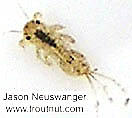 View 3 PicturesThis nymph is an extremely early instar (Instar: Many invertebrates molt through dozens of progressively larger and better-developed stages as they grow. Each of these stages is known as an instar. Hard-bodied nymphs typically molt through more instars than soft-bodied larvae.).
View 3 PicturesThis nymph is an extremely early instar (Instar: Many invertebrates molt through dozens of progressively larger and better-developed stages as they grow. Each of these stages is known as an instar. Hard-bodied nymphs typically molt through more instars than soft-bodied larvae.).
 View 3 PicturesThis nymph is an extremely early instar (Instar: Many invertebrates molt through dozens of progressively larger and better-developed stages as they grow. Each of these stages is known as an instar. Hard-bodied nymphs typically molt through more instars than soft-bodied larvae.).
View 3 PicturesThis nymph is an extremely early instar (Instar: Many invertebrates molt through dozens of progressively larger and better-developed stages as they grow. Each of these stages is known as an instar. Hard-bodied nymphs typically molt through more instars than soft-bodied larvae.).Collected February 7, 2004 from unknown in Wisconsin
Added to Troutnut.com by Troutnut on January 25, 2006
Added to Troutnut.com by Troutnut on January 25, 2006
Eurylophella (Chocolate Duns) Mayfly Nymph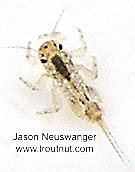 View 3 PicturesThis nymph is an extremely early instar (Instar: Many invertebrates molt through dozens of progressively larger and better-developed stages as they grow. Each of these stages is known as an instar. Hard-bodied nymphs typically molt through more instars than soft-bodied larvae.).
View 3 PicturesThis nymph is an extremely early instar (Instar: Many invertebrates molt through dozens of progressively larger and better-developed stages as they grow. Each of these stages is known as an instar. Hard-bodied nymphs typically molt through more instars than soft-bodied larvae.).
 View 3 PicturesThis nymph is an extremely early instar (Instar: Many invertebrates molt through dozens of progressively larger and better-developed stages as they grow. Each of these stages is known as an instar. Hard-bodied nymphs typically molt through more instars than soft-bodied larvae.).
View 3 PicturesThis nymph is an extremely early instar (Instar: Many invertebrates molt through dozens of progressively larger and better-developed stages as they grow. Each of these stages is known as an instar. Hard-bodied nymphs typically molt through more instars than soft-bodied larvae.).Collected February 7, 2004 from unknown in Wisconsin
Added to Troutnut.com by Troutnut on January 25, 2006
Added to Troutnut.com by Troutnut on January 25, 2006
Male Ephemerella subvaria (Hendrickson) Mayfly Dun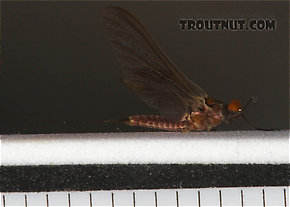 View 4 Pictures
View 4 Pictures
 View 4 Pictures
View 4 PicturesCollected May 7, 2005 from the West Branch of the Delaware River in New York
Added to Troutnut.com by Troutnut on May 16, 2006
Added to Troutnut.com by Troutnut on May 16, 2006
Ephemerella invaria (Sulphur Dun) Mayfly Nymph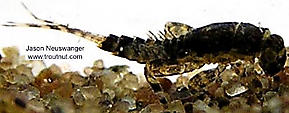 View 4 PicturesI looked at this nymph closely under a microscope to ascertain some key features I was wondering about in previous photographs of similar specimens. It definitely does have the fan-tail characteristic of the Ephemerella genus. It also has strongly 2-banded tibiae (
View 4 PicturesI looked at this nymph closely under a microscope to ascertain some key features I was wondering about in previous photographs of similar specimens. It definitely does have the fan-tail characteristic of the Ephemerella genus. It also has strongly 2-banded tibiae (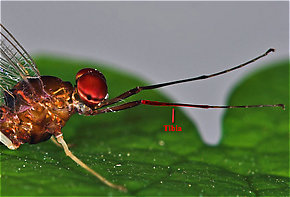 Tibia: A middle segments in the leg of an insect, located between the femur and the tarsus.) and definite tiny abdominal tubercles (
Tibia: A middle segments in the leg of an insect, located between the femur and the tarsus.) and definite tiny abdominal tubercles (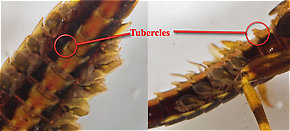 Tubercle: Various peculiar little bumps or projections on an insect. Their character is important for the identification of many kinds of insects, such as the nymphs of Ephemerellidae mayflies.).
Tubercle: Various peculiar little bumps or projections on an insect. Their character is important for the identification of many kinds of insects, such as the nymphs of Ephemerellidae mayflies.).
 View 4 PicturesI looked at this nymph closely under a microscope to ascertain some key features I was wondering about in previous photographs of similar specimens. It definitely does have the fan-tail characteristic of the Ephemerella genus. It also has strongly 2-banded tibiae (
View 4 PicturesI looked at this nymph closely under a microscope to ascertain some key features I was wondering about in previous photographs of similar specimens. It definitely does have the fan-tail characteristic of the Ephemerella genus. It also has strongly 2-banded tibiae (
The tibia of this Isonychia bicolor mayfly spinner is highlighted in red.

A few (not all) of the abdominal tubercles on this Ephemerella needhami nymph are circled. They are especially large in this species.
Collected February 7, 2004 from unknown in Wisconsin
Added to Troutnut.com by Troutnut on January 25, 2006
Added to Troutnut.com by Troutnut on January 25, 2006
Eurylophella (Chocolate Duns) Mayfly Nymph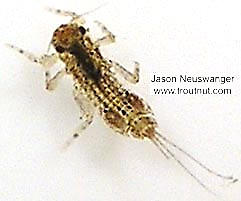 View 3 Pictures
View 3 Pictures
 View 3 Pictures
View 3 PicturesCollected February 7, 2004 from unknown in Wisconsin
Added to Troutnut.com by Troutnut on January 25, 2006
Added to Troutnut.com by Troutnut on January 25, 2006
Ephemerella subvaria (Hendrickson) Mayfly Nymph View 3 PicturesThis is another peculiar brownish Ephemerella. It has double-banded tibiae (
View 3 PicturesThis is another peculiar brownish Ephemerella. It has double-banded tibiae ( Tibia: A middle segments in the leg of an insect, located between the femur and the tarsus.) and prominent black-fringed tubercles (
Tibia: A middle segments in the leg of an insect, located between the femur and the tarsus.) and prominent black-fringed tubercles ( Tubercle: Various peculiar little bumps or projections on an insect. Their character is important for the identification of many kinds of insects, such as the nymphs of Ephemerellidae mayflies.).
Tubercle: Various peculiar little bumps or projections on an insect. Their character is important for the identification of many kinds of insects, such as the nymphs of Ephemerellidae mayflies.).
 View 3 PicturesThis is another peculiar brownish Ephemerella. It has double-banded tibiae (
View 3 PicturesThis is another peculiar brownish Ephemerella. It has double-banded tibiae (
The tibia of this Isonychia bicolor mayfly spinner is highlighted in red.

A few (not all) of the abdominal tubercles on this Ephemerella needhami nymph are circled. They are especially large in this species.
Collected February 7, 2004 from unknown in Wisconsin
Added to Troutnut.com by Troutnut on January 25, 2006
Added to Troutnut.com by Troutnut on January 25, 2006
Eurylophella (Chocolate Duns) Mayfly Nymph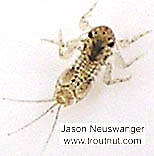 View 3 PicturesThis nymph is an extremely early instar (Instar: Many invertebrates molt through dozens of progressively larger and better-developed stages as they grow. Each of these stages is known as an instar. Hard-bodied nymphs typically molt through more instars than soft-bodied larvae.).
View 3 PicturesThis nymph is an extremely early instar (Instar: Many invertebrates molt through dozens of progressively larger and better-developed stages as they grow. Each of these stages is known as an instar. Hard-bodied nymphs typically molt through more instars than soft-bodied larvae.).
 View 3 PicturesThis nymph is an extremely early instar (Instar: Many invertebrates molt through dozens of progressively larger and better-developed stages as they grow. Each of these stages is known as an instar. Hard-bodied nymphs typically molt through more instars than soft-bodied larvae.).
View 3 PicturesThis nymph is an extremely early instar (Instar: Many invertebrates molt through dozens of progressively larger and better-developed stages as they grow. Each of these stages is known as an instar. Hard-bodied nymphs typically molt through more instars than soft-bodied larvae.).Collected February 7, 2004 from unknown in Wisconsin
Added to Troutnut.com by Troutnut on January 25, 2006
Added to Troutnut.com by Troutnut on January 25, 2006
Female Ephemerella invaria (Sulphur Dun) Mayfly Dun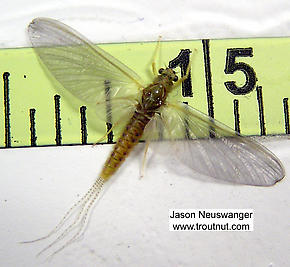 View 4 Pictures
View 4 Pictures
 View 4 Pictures
View 4 PicturesCollected May 23, 2004 from unknown in Wisconsin
Added to Troutnut.com by Troutnut on January 25, 2006
Added to Troutnut.com by Troutnut on January 25, 2006
Female Ephemerellidae (Hendricksons, Sulphurs, PMDs, BWOs) Mayfly Spinner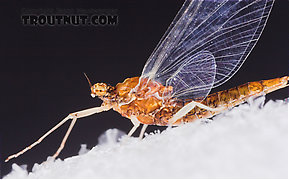 View 7 PicturesThis Ephemerellidae spinner was emerging unusually late, and on a warm stream. Since it's a female, identification is difficult. Her identical coloration suggests she's probably of the same species as this specimen collected on a cool trout stream almost a month earlier.
View 7 PicturesThis Ephemerellidae spinner was emerging unusually late, and on a warm stream. Since it's a female, identification is difficult. Her identical coloration suggests she's probably of the same species as this specimen collected on a cool trout stream almost a month earlier.
 View 7 PicturesThis Ephemerellidae spinner was emerging unusually late, and on a warm stream. Since it's a female, identification is difficult. Her identical coloration suggests she's probably of the same species as this specimen collected on a cool trout stream almost a month earlier.
View 7 PicturesThis Ephemerellidae spinner was emerging unusually late, and on a warm stream. Since it's a female, identification is difficult. Her identical coloration suggests she's probably of the same species as this specimen collected on a cool trout stream almost a month earlier.Collected July 28, 2005 from the West Fork of the Chippewa River in Wisconsin
Added to Troutnut.com by Troutnut on April 14, 2006
Added to Troutnut.com by Troutnut on April 14, 2006
Female Ephemerella excrucians (Pale Morning Dun) Mayfly Dun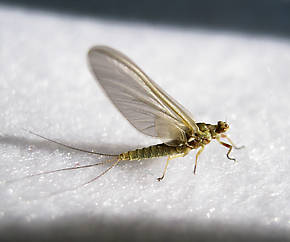 View 3 PicturesSize: 10mm. At emergence the specimen was a fairly bright olive green and there was obvious difference in color between the forewing (med. dun) and the hind-wing (pale cream). It was really noticeable as they floated by. You can just make these features out in the second photo, but not so much in the first that was taken 24 hours after capture. Total time from emergence to molting - approx. 48 hours.
View 3 PicturesSize: 10mm. At emergence the specimen was a fairly bright olive green and there was obvious difference in color between the forewing (med. dun) and the hind-wing (pale cream). It was really noticeable as they floated by. You can just make these features out in the second photo, but not so much in the first that was taken 24 hours after capture. Total time from emergence to molting - approx. 48 hours.
Entoman
Edit 2/25/13 - This specimen was originally posted to E. d. infrequens because of its size. It turns out large size doesn't hold up as a way to tell these two apart. This is because excrucians has much greater variability than previously understood. The assumption by anglers that excrucians is always the smaller of the two is apparently not supported by science. There is a lot left to sort out with western Ephemerella species. This may include new discoveries and/or synonyms (Synonym: A former name of a taxon, usually a species. Entomologists frequently discover that two insects originally described as different species are one in the same, and they drop one of the names. The dropped name is said to be a synonym of the remaining name. These changes take a while to trickle into the common knowledge of anglers; for example, Baetis vagans is now a synonym of Baetis tricaudatus.) as well as reportage on new intraspecific variations broadening the descriptions of recognized species. Based on this specimen's Fall maturity, the best guess is that it is an unusual form of excrucians.
As to color, both species duns (nymphs too) demonstrate a tremendous amount of intraspecific variability from pale yellow to bright green with a multitude of sulfur shadings in between, ranging from pale amber, through orange to cinnamon and even dark brown. I've seen wings from pale cream through tannish and almost every shade of dun except the dark shades. Some have pigment stained leading edges matching their bodies, some don't. Most of these variations are undocumented except in angler references and periodicals. It seems a rare year that a new variation doesn't pop up to the notice of anglers.
Bottom line - size is only reliable if the specimens are smaller than size 16, pointing to excrucians. Otherwise, the only fairly dependable way to tell them apart (especially the females) is by timing as infrequens is the first of the two to appear, rarely lasting longer than a couple of weeks or later than the end of June most years. The problem with using timing for determination is it requires knowledge of the hatch sequences as they actually occurred for a given year on a given piece of water. Obviously, this kind of information is seldom available. Without it, determining between the two duns if they are larger than size 18 is speculative at best - at least until very late in the Summer.
 View 3 PicturesSize: 10mm. At emergence the specimen was a fairly bright olive green and there was obvious difference in color between the forewing (med. dun) and the hind-wing (pale cream). It was really noticeable as they floated by. You can just make these features out in the second photo, but not so much in the first that was taken 24 hours after capture. Total time from emergence to molting - approx. 48 hours.
View 3 PicturesSize: 10mm. At emergence the specimen was a fairly bright olive green and there was obvious difference in color between the forewing (med. dun) and the hind-wing (pale cream). It was really noticeable as they floated by. You can just make these features out in the second photo, but not so much in the first that was taken 24 hours after capture. Total time from emergence to molting - approx. 48 hours.Entoman
Edit 2/25/13 - This specimen was originally posted to E. d. infrequens because of its size. It turns out large size doesn't hold up as a way to tell these two apart. This is because excrucians has much greater variability than previously understood. The assumption by anglers that excrucians is always the smaller of the two is apparently not supported by science. There is a lot left to sort out with western Ephemerella species. This may include new discoveries and/or synonyms (Synonym: A former name of a taxon, usually a species. Entomologists frequently discover that two insects originally described as different species are one in the same, and they drop one of the names. The dropped name is said to be a synonym of the remaining name. These changes take a while to trickle into the common knowledge of anglers; for example, Baetis vagans is now a synonym of Baetis tricaudatus.) as well as reportage on new intraspecific variations broadening the descriptions of recognized species. Based on this specimen's Fall maturity, the best guess is that it is an unusual form of excrucians.
As to color, both species duns (nymphs too) demonstrate a tremendous amount of intraspecific variability from pale yellow to bright green with a multitude of sulfur shadings in between, ranging from pale amber, through orange to cinnamon and even dark brown. I've seen wings from pale cream through tannish and almost every shade of dun except the dark shades. Some have pigment stained leading edges matching their bodies, some don't. Most of these variations are undocumented except in angler references and periodicals. It seems a rare year that a new variation doesn't pop up to the notice of anglers.
Bottom line - size is only reliable if the specimens are smaller than size 16, pointing to excrucians. Otherwise, the only fairly dependable way to tell them apart (especially the females) is by timing as infrequens is the first of the two to appear, rarely lasting longer than a couple of weeks or later than the end of June most years. The problem with using timing for determination is it requires knowledge of the hatch sequences as they actually occurred for a given year on a given piece of water. Obviously, this kind of information is seldom available. Without it, determining between the two duns if they are larger than size 18 is speculative at best - at least until very late in the Summer.
Collected October 16, 2011 from the Fall River in California
Added to Troutnut.com by Entoman on October 21, 2011
Added to Troutnut.com by Entoman on October 21, 2011
Top 10 Fly Hatches
Top Gift Shop Designs
Eat mayflies.
Top Insect Specimens
Miscellaneous Sites
Troutnut.com is copyright © 2004-2024 Jason
Neuswanger (email Jason). See my FAQ for information about use of my images.
 privacy policy
privacy policy
